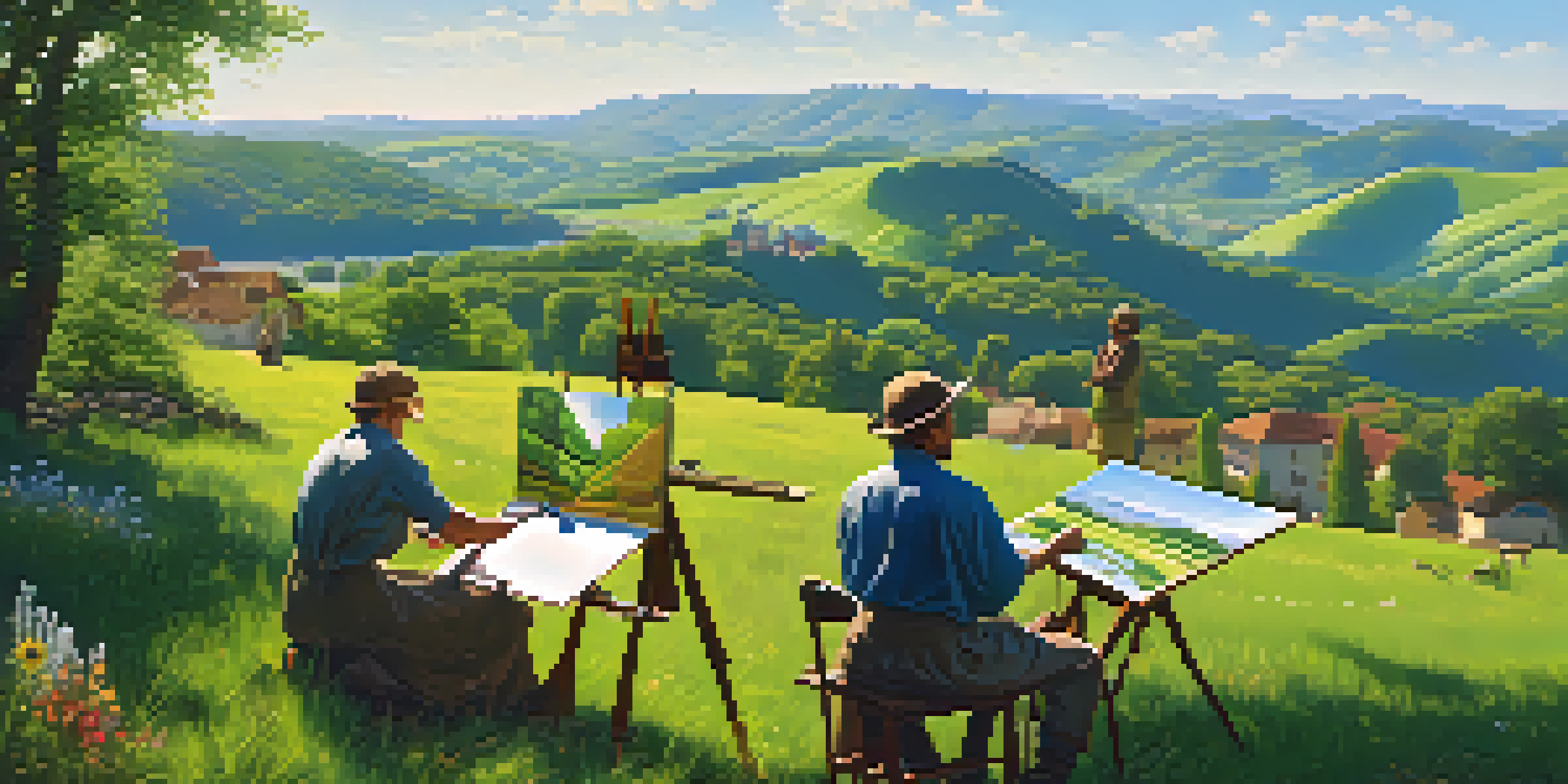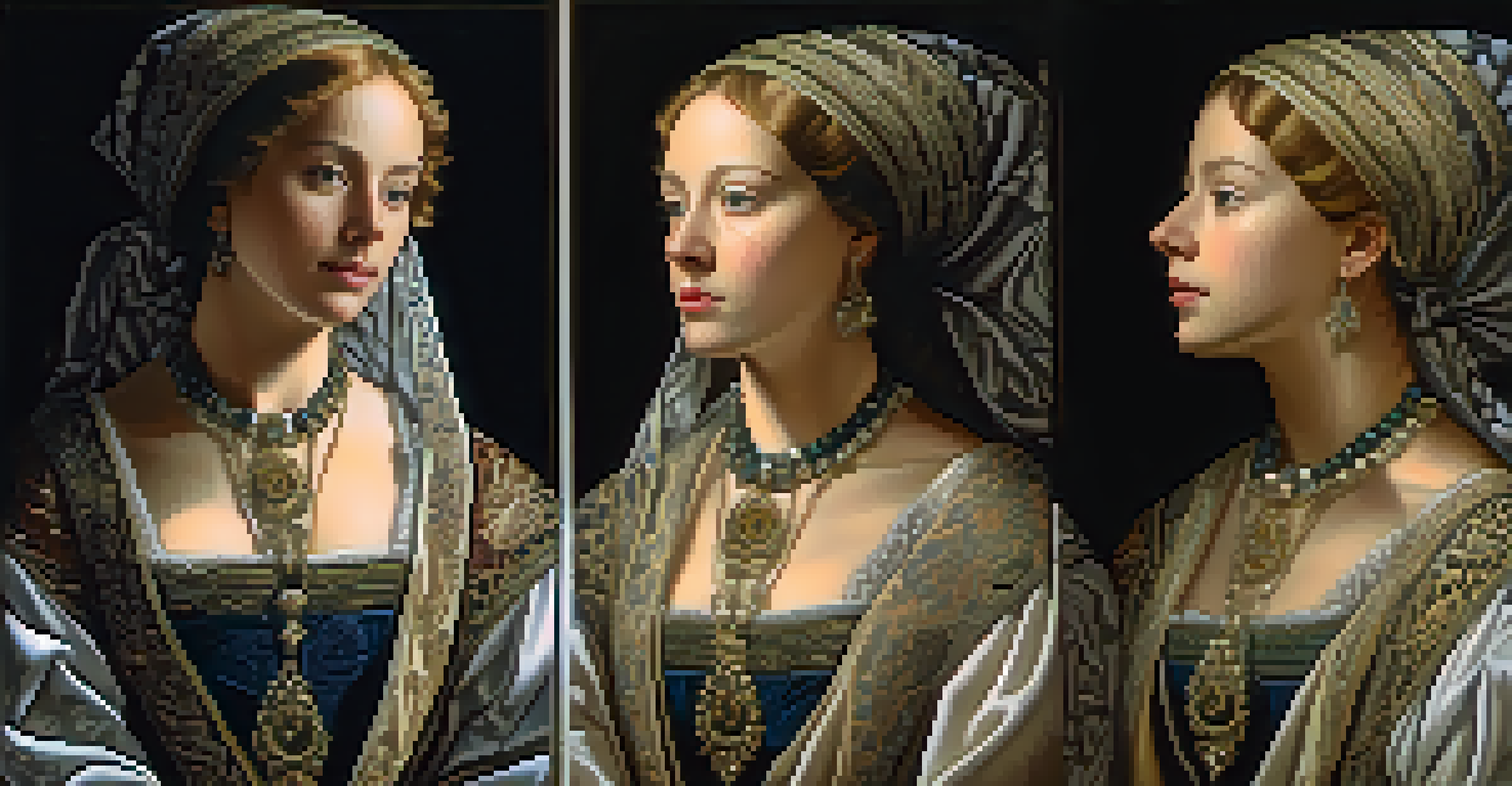Renaissance Art: Humanism and the Celebration of Individuality

Understanding the Renaissance: A Shift in Perspective
The Renaissance, which spanned from the 14th to the 17th century, marked a profound shift in cultural and artistic expression in Europe. It was a time when scholars and artists began to look back to the classical antiquities of Greece and Rome, seeking inspiration from their ideals of beauty and knowledge. This revival of classical learning laid the groundwork for humanism, a movement that emphasized the potential and achievements of individuals. As a result, art during this period became a mirror reflecting human experience and emotion.
The great man is a product of his time and a product of his place.
Humanism celebrated the individual and encouraged a focus on human potential and achievements rather than solely religious themes. Artists began to explore subjects like portraiture and scenes of everyday life, in stark contrast to the predominantly religious art of the Middle Ages. This newfound emphasis on the human experience helped to elevate the status of artists, allowing them to become recognized as skilled individuals rather than mere craftsmen. It was a cultural awakening that celebrated the beauty of being human.
This shift in perspective not only influenced art but also impacted literature, philosophy, and science. Thinkers like Leonardo da Vinci and Michelangelo became paragons of this new ideal, blending artistry with deep intellectual inquiry. Ultimately, the Renaissance represented a collective journey towards understanding individuality and the complexities of the human condition, setting the stage for future artistic movements.
The Role of Humanism in Artistic Expression
Humanism played a pivotal role in shaping the artistic landscape of the Renaissance. It encouraged artists to draw inspiration from nature and the human form, leading to a more realistic representation of subjects. This newfound focus on the individual human experience meant that artists began to infuse their works with emotion, depth, and personal narrative. The result was a more relatable and accessible art form that resonated with a broader audience.

One of the most notable examples of humanism in art is the use of perspective, which allowed artists to create a sense of depth and space. Through techniques like linear perspective, artists could depict the human figure more dynamically within a three-dimensional space. This innovation not only enhanced the realism of the artwork but also invited viewers to engage with the piece on a more personal level. It was as if the viewer was stepping into a world where individual stories unfolded.
Renaissance Redefines Humanism
The Renaissance marked a cultural shift that celebrated individual potential and achievements, moving away from solely religious themes.
Moreover, artists began to portray historical and mythological figures with human characteristics and emotions, making them relatable. Instead of presenting saints and biblical figures as distant and idealized, they depicted them with flaws and vulnerabilities. This approach not only made the artworks more engaging but also highlighted the complexities of human nature, celebrating individuality in all its forms.
Prominent Artists and Their Humanist Influences
Several artists emerged during the Renaissance who embodied the principles of humanism through their work. Leonardo da Vinci, often hailed as a quintessential Renaissance man, combined art and science in ways that showcased human potential and intellect. His masterpieces, such as the 'Mona Lisa' and 'The Last Supper,' illustrate not only technical skill but also an understanding of human emotion and psychology. Da Vinci’s work invites viewers to ponder the deeper meanings behind the expressions of his subjects, emphasizing individuality.
Every artist was first an amateur.
Michelangelo is another key figure whose art reflects the humanist ideals of the Renaissance. His sculptures, like 'David,' capture the beauty of the human form and the spirit of individualism. David is not just a biblical hero; he is a symbol of human strength and resilience. Michelangelo's ability to convey emotion through marble demonstrates a profound understanding of humanity, reinforcing the celebration of individuality in his art.
Raphael, known for his harmonious compositions, also contributed significantly to the humanist movement. His works often depicted scenes of human interaction and emotion, such as in 'The School of Athens,' where he gathered great thinkers from different eras in a single space. By portraying these historical figures with distinct personalities and expressions, Raphael highlighted the importance of individual thought and contribution to society, further solidifying the humanist ideals of the Renaissance.
Renaissance Art Techniques That Highlight Individuality
The techniques employed by Renaissance artists significantly contributed to the celebration of individuality. One such technique was chiaroscuro, which involved the use of light and shadow to create a sense of volume and dimensionality in painting. This method not only enhanced the realism of the figures but also added emotional depth, allowing artists to convey the intricacies of individual characters. The interplay of light and shadow became a powerful tool in expressing personal narratives within the artwork.
Another important technique was sfumato, a method popularized by Leonardo da Vinci that involved the subtle blending of colors and tones. This technique created soft transitions between colors, allowing for a more natural representation of the human face and form. The result was a lifelike quality that made subjects appear more relatable and human. Artists used sfumato to convey the complexities of emotions, further emphasizing the individuality of their subjects.
Art Techniques Showcase Individuality
Innovative techniques like chiaroscuro and sfumato allowed artists to depict more realistic and emotionally resonant human figures.
The use of anatomical studies also played a crucial role in the depiction of individuality. Artists like Michelangelo and da Vinci meticulously studied the human body, capturing its nuances and variations. Their understanding of anatomy allowed them to portray figures with accuracy and expressiveness, celebrating the uniqueness of each individual. This dedication to realism and attention to detail in their work was a testament to the Renaissance's commitment to honoring human individuality.
Influence of Classical Antiquity on Renaissance Humanism
The Renaissance was deeply influenced by the ideals of classical antiquity, particularly in its emphasis on humanism. Scholars and artists alike sought inspiration from ancient Greek and Roman texts, art, and philosophy. This revival led to a renewed appreciation for the value of human experience and the potential for individual greatness. The classics served as a foundation for Renaissance thinkers to explore concepts of beauty, ethics, and the nature of humanity, ultimately shaping the era's artistic output.
Incorporating classical themes into their work allowed artists to connect the past with the present, bringing timeless human experiences to life. For instance, many Renaissance artists drew on mythological stories, depicting gods and heroes in a way that highlighted their human traits. This blending of classical mythology with contemporary themes underscored the enduring relevance of individual stories and experiences throughout history.
Moreover, the revival of classical architecture and sculpture set a standard for beauty that Renaissance artists aimed to achieve. The use of symmetry, proportion, and harmony in their works echoed the principles found in ancient art, further enhancing the celebration of individuality. By marrying classical ideals with contemporary humanist thought, Renaissance artists created a new artistic language that celebrated the intricacies and diversity of individual human experience.
The Legacy of Renaissance Art and Individualism
The impact of Renaissance art extends far beyond its time, laying the groundwork for future artistic movements and shaping our understanding of individuality. The emphasis on human emotion, depth, and personal narrative became hallmarks of art in subsequent eras, influencing everything from Baroque to Romanticism. Artists who followed in the footsteps of the Renaissance were inspired to explore the complexities of the human experience, often prioritizing individual expression in their work.
The legacy of humanism and individuality in art can also be seen in modern and contemporary works. Artists today continue to draw on the themes established during the Renaissance, exploring personal identity, cultural backgrounds, and emotional experiences. The celebration of individuality has become a cornerstone of artistic expression, encouraging artists to share their unique perspectives with the world.
Legacy of Individualism in Art
The emphasis on individual stories and emotions in Renaissance art laid the groundwork for future artistic movements and continues to influence modern expression.
Additionally, the Renaissance's focus on the individual has infiltrated various aspects of culture and society. From literature to philosophy, the notion of individualism remains a powerful force, reminding us of the importance of personal stories and experiences. As we reflect on the Renaissance, we recognize its enduring influence in promoting the idea that every individual has a story worth telling.
Conclusion: Embracing Individuality Through Art
In conclusion, Renaissance art represents a significant turning point in the celebration of humanism and individuality. The artists of this period broke away from the constraints of medieval art, choosing instead to explore the richness of human experience. By focusing on individual stories, emotions, and the beauty of the human form, they created works that continue to resonate with us today.
The techniques and ideals established during the Renaissance laid the foundation for future generations of artists to explore their own identities and express their unique perspectives. The movement's legacy encourages us to appreciate the diversity of human experiences and the importance of individuality in art and life. It reminds us that every person has a unique story that contributes to the rich tapestry of humanity.

As we engage with Renaissance art, we are invited to reflect on our own individuality and the ways in which we can express it. Whether through art, literature, or personal experiences, the celebration of the individual continues to inspire creativity and connection. The Renaissance serves as a powerful reminder that art is not just about aesthetics; it is a profound expression of what it means to be human.